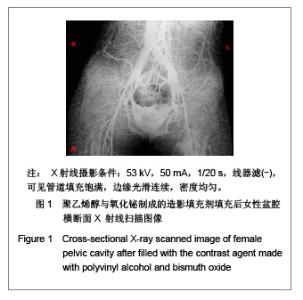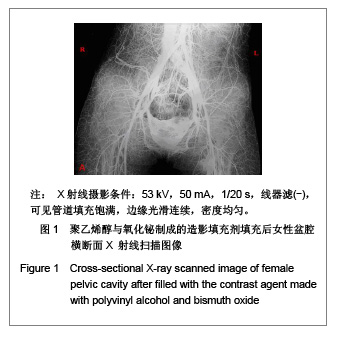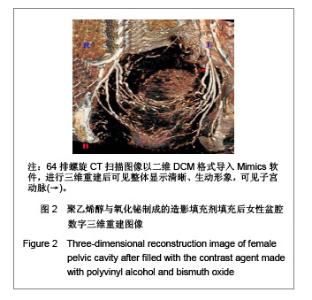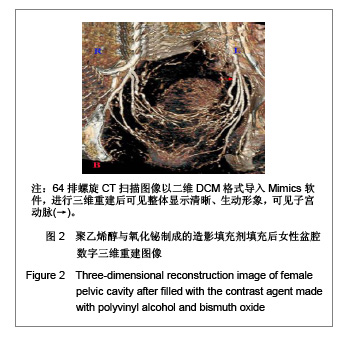| [1] Wen X, Sun WD, Wang XH, et al. Zhongguo Linchuang Jiepouxue Zazhi. 2005;23(1):72-75. 温昔,孙文娣,王学慧,等.子宫动脉上行支的解剖学研究及临床意义[J].中国临床解剖学杂志,2005,23(1):72-75.[2] Chen CL, Huang R, Liu P, et al. Zhongguo SHiyong Fuke yu Chanke Zazhi. 2009;25(2):117-120. 陈春林,黄睿,刘萍,等.人正常离体子宫动脉血管网三维模型的构建及意义[J].中国实用妇科与产科杂志,2009,25(2):117-120.[3] Chen CL. Zhongguo SHiyong Fuke yu Chanke Zazhi. 2009; 25(3):169-172. 陈春林.宫颈周围立体环的逆行解剖与经阴道手术[J].中国实用妇科与产科杂志,2009,25(3):169-172.[4] Tang XY, Yuan LJ, Jiang MK, et al. Zuzhong Yu Shenjing Jibing Zazhi. 2010;17(6):365-366. 唐向阳,袁良津,蒋鸣坤,等.缺血性脑血管病TCD、CTA与DSA检查的对比分析[J].卒中与神经疾病杂志,2010,17(6):365-366. [5] Jiang JD, Tan LL, Li YB, et al. Guangdong Yixue. 2006; 27(5):623-626. 江金带,谭理连,李扬彬,等.16层螺旋CT髂动脉血管造影在肾移植术后的应用[J].广东医学,2006,27(5):623-626.[6] Wang Y, Han MJ, Zhao H, et al. Guangdong Yixue. 2006; 27(5):625-626. 王颖,韩铭钧,赵虹,等.多层螺旋CT两种重建方式检测冠状动脉钙化斑块的比较与评价[J].广东医学,2006,27(5):625-626.[7] Song XL. Nanfang Yike Daxue. 2011. 宋小磊.子宫静脉血管网数字化三维模型的初步研究[D].南方医科大学,2011.[8] Gao CJ, Xu DC. Diyi Junyi Daxue. 2006. 高成杰,徐达传.多层螺旋CT辅助人体盆腔血管形态学研究[D].第一军医大学,2006.[9] Bajka M, Manestar M, Hug J, et al. Detailed anatomy of the ab2domen and pelvis of the visible human female.Clin Anatomy. 2004;17(5):252-260.[10] Gao CJ, Yuan XJ, Pei Q, et al. ZHongguo Linchuang Jiepouxue Zazhi. 2006;24(1):39-42. 高成杰,原晓景,裴强,等.成人盆腔血管多层螺旋CT三维重建初步研究[J].中国临床解剖学杂志,2006,24(1):39-42.[11] San JL, Zhang SY, Tan LW, et al. ZHongguo Jieru Yingxiang yu Zhiliaoxue. 2007;4(5):338-391. 单锦露,张绍祥,谭立文,等.盆腔动脉三维重建研究及其临床意义[J].中国介入影像与治疗学,2007,4(5):338-391.[12] Ding HM, Yin ZX, Zhou XB, et al. Three-dimensional visualization of pelvic vascularity. Surg Radiol Anat. 2008; 30(5):437-442. [13] Shi XT, Yi XN, Wang M, et al. Jiepouxue Zazhi. 2010; 33(4): 558-559. 石小田,易西南,王淼,等.聚乙烯醇-氧化铈人体血管造影术[J].解剖学杂志,2010,33(4):558-559.[14] Gao CJ, Xu DC, Pei Q, et al. Pelvic artery representation on three-dimensional reconstructed multislice spiral CT images: variability between the young and the elderly. Nan Fang Yi Ke Da Xue Xue Bao. 2006;26(5):670-673. [15] Teoh R, Johnson RF, Nishino TK, et al. Evaluation of three-dimensional computed tomography processing for deep inferior epigastric perforator flap breast reconstruction. Can J Plast Surg. 2007;15(4):196-198.[16] Naguib NN, Nour-Eldin NE, Hammerstingl RM, et al. Three-dimensional reconstructed contrast-enhanced MR angiography for internal iliac artery branch visualization before uterine artery embolization. J Vasc Interv Radiol. 2008;19(11):1569-1575.[17] Herman† GT, Liu HK. Three-dimensional display of human organs from computedtomograms. 1979;9(1):1-21.[18] Villa M, Saint-Cyr M, Wong C, et al. Extended vertical rectus abdominis myocutaneous flap for pelvic reconstruction: three-dimensional and four-dimensional computed tomography angiographic perfusion study and clinical outcome analysis. Plast Reconstr Surg. 2011;127(1):200-209.[19] Zhang MY, Zhao YK. Hebei Yiyao. 2008;2:212-214. 张美云,赵映魁.子宫动脉栓塞术副反应及并发症研究进展[J]. 河北医药,2008,2:212-214.[20] Feng Q, He CH, Wan Q, et al. Shandong Yiyao. 2011;51(15): 109-110. 冯晴,贺春花,万琪,等.子宫动脉栓塞术在子宫肌瘤治疗中的应用进展[J].山东医药,2011,51(15):109-110.[21] Tan GS, Guo WB, Fan HS, et al. Jieru Fangshexue Zazhi. 2010; 2(19):110-113. 谭国胜,郭文波,范惠双,等.子宫动脉栓塞治疗子宫肌瘤的动态影像学监测及其机制研究[J].介入放射学杂志,2010,2(19): 110-113.[22] Xu YJ, Ouyang Zhenbo, Liu P, et al. ZHongguo SHiyong Fuke yu Chanke Zazhi. 2011;27(4):305-307. 徐玉静,欧阳振波,刘萍,等.磁共振成像在子宫肌瘤动脉栓塞术中的应用价值[J].中国实用妇科与产科杂志,2011,27(4):305-307.[23] Zhang GF, Han ZG, Hu PA, et al. Jieru Fangshexue Zazhi. 2010;12:951-953. 张国福,韩志刚,胡培安,等.选择性子宫动脉栓塞术在症状性子宫肌瘤中的应用[J].介入放射学杂志,2010,12:951-953.[24] Liu P. ZHongguo SHiyong Fuke yu Chanke Zazhi. 2009;25(3): 197-198. 刘萍.子宫动脉血管网建模与子宫动脉栓塞术[J].中国实用妇科与产科杂志,2009,25(3):197-198.[25] Chen CL, Xu YJ, Liu P, et al. Jieru Fangshexue Zazhi. 2012; 21(1):35-39. 陈春林,徐玉静,刘萍,等.子宫肌瘤数字化三维动脉血管网的构建和意义[J].介入放射学志,2012,21(1):35-39.[26] Lv J, Lei WH, Ran H, et al. Guangdong Yixue. 2011;32(7): 848-850. 吕军,雷蔚华,冉虹,等.子宫动脉栓塞治疗对子宫内膜功能影响的超声随访评估[J].广东医学,2011,32(7):848-850.[27] Jiang N, Li YX, Chen J. Yixue Lilun yu Shijian. 2011;24(7): 808-809. 蒋娜,李雅欣,陈静.子宫动脉栓塞术的临床应用分析[J].医学理论与实践,2011,24(7):808-809.[28] Sun H. Qiqi Haer Yixueyuan Xuebao. 2010;31(8):1240-1241. 孙晖.子宫动脉栓塞术与腹腔镜下治疗子宫肌瘤对卵巢影响的比较研究[J].齐齐哈尔医学院学报,2010,31(8):1240-1241.[29] Qu WH, Guo P, Wu YM. Shingyong Yiji Zazhi. 2011;18(6): 573-576. 屈文华,郭平,武永明.子宫动脉栓塞治疗症状性子宫肌瘤的临床研究[J].实用医技杂志,2011,18(6):573-576.[30] Huang X, Harder R, Leake S, et al. Three-dimensional Bragg coherent diffraction imaging of an extended ZnO crystal. J Appl Crystallogr. 2012;45(Pt 4):778-784. |



